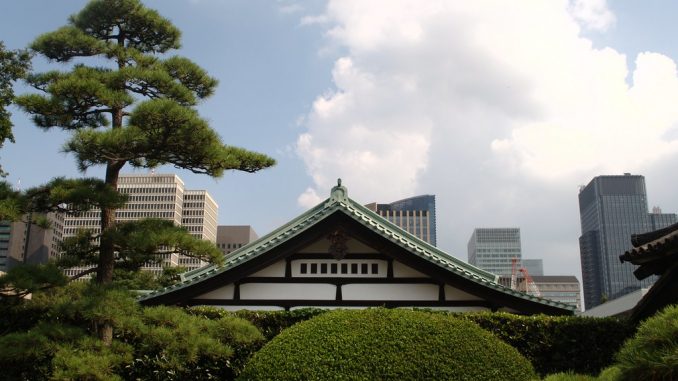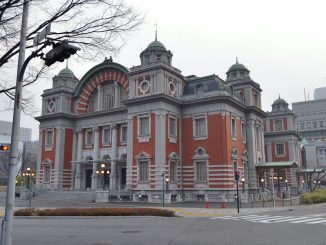
Located in the Chiyoda ward of Tokyo, the Imperial Palace of Japan occupies the same site of the original the Tokugawa shogunate’s castle, the Edo-jō. During its peak it was the largest fortress in the world, but apart from a moat and some stone walls, little of the original structure remains intact today. Japan was founded in 660 BC by Emperor Jimmu, a direct descendant of the sun-goddess Amaterasu, and the Imperial House of Japan has been made up of his decedents ever sense, making it the oldest continuing monarchy in the world. Tokyo though was not always the home of the emperor, and it wasn’t till the late 1800s that he moved his residence from Kyoto. Because he has not (on a historical scale) been living in Tokyo that long, there is less history in the palace than you might think.
The location of the Tokugawa shogunate’s castle was always important geographically in the city and had been at the center of the government since the 1600s, but due to multiple fires and constant construction, little of what was there at the beginning still stands today. In 1868, the Meiji restoration removed any power from the shogunate and returned it to the Emperor. It was at this time that all the residents of the Edo-jō were required to vacate and the Emperor took control and renamed it to Tōkei Castle. It was renamed the Imperial Castle just one year later in 1869.
Since The Imperial Palace is the Emperor if Japan’s home, the 3.4sq-km complex is largely off limits to the public, but there are free tours organized by the Imperial Household Agency to see parts of the compound. The palace is not just the private residence of the Imperial Family though, it also contains an archive, museums, administrative offices, and numerous event spaces for hosting international guests and playing a role for ceremonial occasions.
The Imperial Palace was the target of a special mission on July 29, 1945, and according to the US bomber pilot Richard Lineberger, it was hit with 2000-pound bombs. Despite heavy damage to the palace, the Emperor stayed and it was here that wartime decisions were made. In August 1945, in the final days of World War II, Emperor Hirohito and his Privy Council made the decision that ultimately culminated in the surrender of Japan. This meeting, like so many others during this time, took place in an underground air-raid shelter on the palace grounds known as His Majesty’s Library.
Large parts of the palace and grounds were destroyed during WWII, but over the years, restoration and renovation breathed new life into the historic site.Today’s palace consists of multiple interconnected modern structures. Finished in 1968, the palace complex, with two stories above ground and one story below, was constructed of steel-framed reinforced concrete. The buildings of the Imperial Palace were constructed in a more modernist style with classic Japanese architectural references.

The East Garden is home to numerous building including the Imperial Tokagakudo (Peach Blossom Music Hall), the Music Department of the Board of Ceremonies of the Imperial Household, and the Archives and Mausolea Department Imperial Household Agency. The Tōkagakudō Music Hall is likely the most well-known building in this portion of the grounds and is located just to the east of the former main donjon of Edo. The hall was designed for commemoration of the 60th birthday of Empress Kōjun on 6 March 1963, and the octagon-shaped hall is decorated with different mosaic tile designs on each of its eight outer walls. Construction began in August 1964 and was completed in February 1966.
Visiting the Imperial Palace
- Tours of the Imperial Palace take approximately 1¼ hours and run from 10am and 1.30pm, Tuesday through Saturday. Tours are not however available on public holidays or in the mornings from late July to the end of August.
- There are no tours of the palace between 28, December and 4, January, or when Imperial Court functions are scheduled.
- Reservations for tours are taken by the Imperial Palace website, phone, or at the Kikyō-mon office. Since it is a royal residence photo ID is required.
- The Imperial Palace East Garden is open to the public without reservations, but you must take a token upon arrival and return it at the end of your visit.
- It can be difficult to book tours on the same day and some people book them up to a month in advance.
Imperial Palace Facts
- Every year on 1 January, a poetry convention called Utakai Hajime is held at the palace.
- On the Emperor’s Birthday, 2, January, the public is permitted to enter through the Nakamon (inner gate) where they can gather in the Kyuden Totei Plaza while the Imperial Family appears on the balcony. The Emperor traditionally thanks them for visiting and wishes them blessings for the next year.
- In the 1980s, Japan was in the midst of a property bubble and the palace with its grounds were valued higher than all of the real estate in the state of California.
- Though it will never come up on the market, it is estimated that the value of the real estate alone is greater than US $1 trillion (that’s $1,000,000,000,000).
- From 1888 to 1948, the compound was called Palace Castle.
- On the night of 25 May 1945, most structures of the Imperial Palace were destroyed in the Allied firebombing raid on Tokyo.
- The most photographed building on the Imperial Palace grounds is not the palace itself but rather an extraordinarily beautiful guards building that stands on the edge of the moat.
